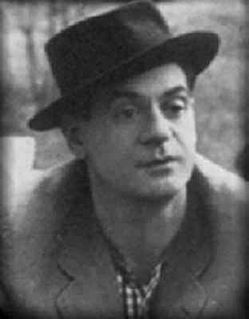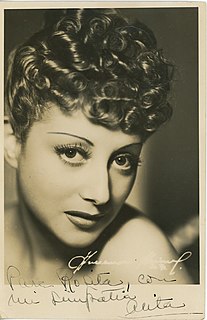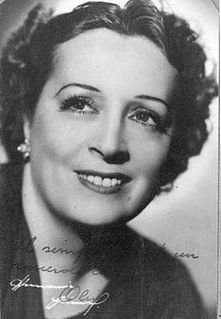
Cinema of Argentina refers to the film industry based in Argentina. The Argentine cinema comprises the art of film and creative movies made within the nation of Argentina or by Argentine filmmakers abroad.

Enrique Telémaco Susini was an Argentine entrepreneur and media pioneer.

Amelia Bence was an Argentine film actress and one of the divas of the Golden Age of Argentine Cinema (1940–60).
Argentina Sono Film S.A.C.I. is an entertainment company based in Buenos Aires that produced most of the major films during the classic period of Argentine cinema from 1933. In its current format, it serves as a production and distribution company.

Laura Ana "Tita" Merello was a prominent Argentine film actress, tango dancer and singer of the Golden Age of Argentine Cinema (1940–1960). In her 6 decades in Argentine entertainment, at the time of her death, she had filmed over thirty movies, premiered twenty plays, had nine television appearances, completed three radio series and had had countless appearances in print media. She was one of the singers who emerged in the 1920s along with Azucena Maizani, Libertad Lamarque, Ada Falcón, and Rosita Quiroga, who created the female voices of tango. She was primarily remembered for the songs "Se dice de mí" and "La milonga y yo".

Luis Sandrini was a prolific Argentine comic film actor and film producer. Widely considered one of the most respected and most acclaimed Argentine comedians by the public and critics. He has made over 80 appearances in film between 1933 and 1980.

Mateo is a 1937 Argentine crime drama film directed by Daniel Tinayre, which he adapted from the play by Armando Discépolo. Starring Luis Arata, Enrique Santos Discépolo, José Gola and Alita Román, it was the first successful film of Tinayre's.

The Newsie and the Lady is a 1938 Argentine comedy film directed and written by Luis César Amadori.

Elvira Fernández, vendedora de tiendas is a 1942 Argentine comedy film directed by Manuel Romero. It stars Paulina Singerman, Juan Carlos Thorry, Tito Lusiardo and Sofía Bozán. The film is about the daughter of a millionaire store owner, who organizes a worker strike.

Alita Blanca Barchigia, better known as Alita Román, was an Argentine film actress of the Golden Age of Argentine Cinema (1940–1960).

Luisa Vehil was an Uruguayan theater and movie actress who had a notable career in Argentina. She was an iconic figure in the Argentine theatre scene.

Olinda Bozán was an Argentine film actress and comedian of the Golden Age of Argentine Cinema (1940–1960). Born into a circus family, she acted on the vaudeville circuit, and performed in silent and sound movies. She was trained by the Podestá brothers, one of whom she married, who have one of the most prestigious Argentine acting awards named for them. Bozán' appeared in 75 films and was considered one of the best comic actors of Argentine cinema in the 20th century.
Raimundo Calcagno, popularly known as Calki, was a prominent Argentine film critic, journalist, and screenwriter. He became known and respected for his reviews in El Mundo in the 1930s. In 1943 he wrote the script for Luis Bayón Herrera's La piel de zapa, and also collaborated in writing the script for Román Viñoly Barreto's Con el sudor de tu frente (1949) and Manuel Antín's Intimidad de los parques (1965).

Los martes, orquídeas is a 1941 Argentine black and white comedy film directed by Francisco Múgica and starring Mirtha Legrand, Enrique Serrano, Juan Carlos Thorry and Nuri Montsé. It won the Argentine Best Picture award for 1941. It was remade as the Hollywood classic You Were Never Lovelier (1942), starring Fred Astaire and Rita Hayworth.

Lumiton is a former film production company and current museum located in Munro, Buenos Aires, Argentina. Lumiton Studios was founded in 1932 at the start of the golden age of film in that country. Its lowbrow, populist films appealed to local audiences and were highly successful in Argentina and throughout Latin America. It was the main competitor to Argentina Sono Film in the 1940s.

La rubia del camino is a 1938 Argentine romantic comedy written and directed by Manuel Romero. Actress Paulina Singerman made her debut in the film.

¡Tango! is a 1933 Argentine musical romance film, the first film to be made in Argentina using optical sound technology Many existing stars of the Argentine stage and radio appeared in the film, but its success was limited due to poor sound quality and weak acting. ¡Tango! established a formula that would be used by many subsequent tango films.

The Englishman of the Bones is a 1940 Argentine drama film based on a novel of the same name.
Dancing is a 1933 Argentine musical film directed by Luis Moglia Barth for Argentina Sono Film. The film's sets were designed by the art director Juan Manuel Concado. It is based on a play by Alejandro Berrutti. Only the second ever sound film to be released in the country after Barth's ¡Tango!, released earlier in 1933, it marked the debut of Amelia Bence, who had a minor role.

Chita Foras (1900–1986), was an Italian-Argentine actress noted for her work in silent and sound films.
















